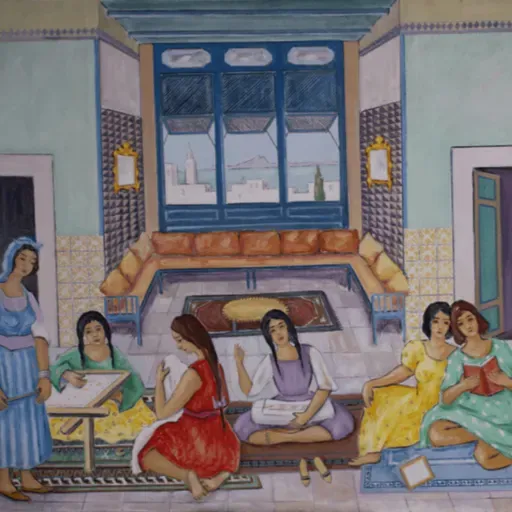
Casa Árabe, with the cooperation of the Tunisian Embassy in Spain, the Ministry of Culture and the National Museum of Modern and Contemporary Art of Tunis, is presenting this opening conference of the exhibition “Tunisian Enlightenments,” to be given by the exhibition’s curator.
Art, though always influenced by the culture and context of its time, also seeks to break free from the boundaries which limit it in order to assert its own voice. The exhibition “Tunisian Enlightenments” invites us to discover the richness and variety of the visual arts in Tunisia, retracing its main stages of development.
One of the most important moments in this history was the advent of the School of Tunis. This artistic movement marked a turning point: the works created not only showed an openness to modernity, but also a strong desire to construct an identity of the country’s own through art.
Before this transformation, most Tunisian creations were closely linked to local traditions. Scenes of the old “medina” and landscapes inspired by the country’s typical architecture were common. However, as of the second half of the twentieth century, with artists such as Zoubeir Turki, Ali Ben Salem and Safia Farhat, in addition to others, a new, more personal and contemporary way of making art began to emerge.
In the seventies, the Nouvelles Tendances (New Trends) movement In the 1970s, the Nouvelles Tendances New Trends) ushered in a wave of innovation. Breaking away from classical models, artists explored new styles and visual languages in search of their own forms of expression in an increasingly globalized world. During the eighties, Tunisian art turned in yet another direction. Abstraction and multiculturalism gained ground, and many artists begin to question longstanding rules, giving rise to new forms of creation. The Galerie Chiyem group and a new generation of creators led this transformation
Today, contemporary art in Tunisia is distinguished by its diverse range of looks and techniques. Light, color and space combine in a constant dialogue with tradition, offering new ways of interpreting and celebrating Tunisian identity
A closer look at all these developments and changes will be performed by Ahlem Boussandel, General Director of the National Museum of Modern and Contemporary Art of Tunisia and the exhibition’s curator. He will be providing an in-depth discussion about this history and evolution in a dialogue with Karim Hauser, from Casa Árabe.
Ahlem Boussandel Jammali is an important figure in the field of art and culture in Tunisia. She holds a PhD in Art Sciences and Techniques from the Higher Institute of Fine Arts of Tunis. She is currently the General Director of the National Museum of Modern and Contemporary Art (MACAM) in Tunis, which plays a key role in preserving and promoting Tunisia’s modern and contemporary art. In addition to her museum work, she teaches at the Higher Institute of Fine Arts in Tunis, where she educates generations of artists and art professionals. At the heart of her cultural commitment, Ahlem Boussandel has managed several major art projects, most notably managing the National Collection through the exhibition of the museum’s permanent collection under the title “Memory of Generations” (1984 - 2024). She also oversaw the “Museum in the Regions” project, which aimed to decentralize access to art in Tunisia. Last but not least, she is also a painter herself, which allows her to maintain an artistic practice while contributing to the development of the Tunisian art scene through her academic and institutional roles.
Image: Dar al mâalma (House of Learning), by Yahia Turki.
Further information: https://en.casaarabe.es/eventos-arabes/show/traces-of-identity-a-journey-through-tunisia%E2%80%99s-visual-arts
